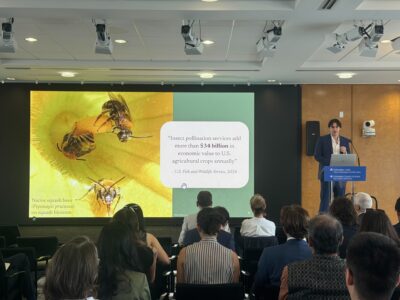
The students in the newest MPA in Environmental Science and Policy cohort have spent the summer semester focusing on climatology, environmental chemistry, and ecology while supplementing classroom learning with field trips around New York. The field trips allow the 60 students to look at classroom topics in a real-world context.
Their first field trip led them to the Gowanus Canal in Brooklyn, where they learned about the Superfund Site that exists just a short subway ride away from Manhattan. The Gowanus Canal was constructed in the 1800s to act as a connection between the two boroughs for industrial and commercial purposes. It quickly became a reservoir for excess sewage, storm water runoff, industrial waste, and other pollutants and contaminants. Students learned about Combined Sewer Overflows (CSOs) in the context of environmental chemistry and toxicology, while focusing on the ramifications of weather events related to climate change, such as Hurricane Sandy, hitting this vulnerable area. The students were led along the 1.8-mile canal by a group of volunteers who are committed to the restoration of the canal.
“It was fascinating to visit the Gowanus Canal and see the real life implications of living next to a Super Fund site, a topic we had been discussing in our Chemistry class,” said Ashley Toombs, a member of the MPA-ESP Class of 2015.
The students were also given the opportunity to visit the Lamont-Doherty Earth Observatory, home to Columbia University researchers focusing on issues ranging from climate

change to environmental degradation. The group spent the day learning about the research that takes place from top scientists in the field, including Sonya Dyhrman, who studies ocean microbes, and geochemist Gisela Winckler. Speakers were able to touch on topics from the students’ chemistry and climatology lectures, while introducing outside research that is currently occurring at the observatory. Students received a brief history of the observatory, including how it became a center for earth science research and how it came to be a part of Columbia University. While on the tour, they were introduced to scientists conducting research on topics ranging from carbon sequestration through the natural weathering of rocks to the extraction of sediment cores from the ocean floor.
Students in the MPA in Environmental Science and Policy program enroll in a year-long, 54-credit program offered at Columbia University’s School of International and Public Affairs, in partnership with the Earth Institute.
Since it began in 2002, the MPA in Environmental Science and Policy program has given students the hands-on experience, and the analytical and decision-making tools to implement effective environmental and sustainable management policies. The program’s 682 graduates have advanced to jobs in domestic and international environmental policy, working in government, private and non-profit sectors. Their work involves issues of sustainability, resource use and global change, in fields focused on air, water, climate, energy efficiency, food, agriculture, transportation and waste management. They work as consultants, advisers, project managers, program directors, policy analysts, teachers, researchers, and environmental scientists and engineers.
Visit our website for more information: http://mpaenvironment.ei.columbia.edu/



